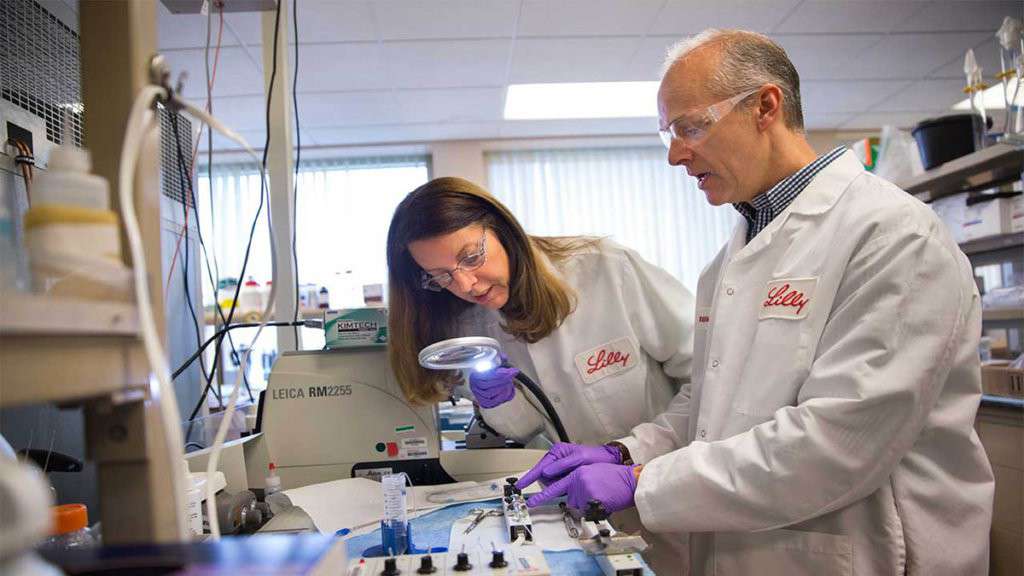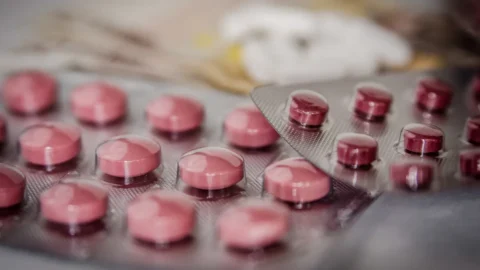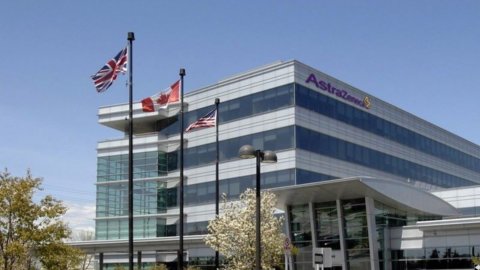Everything you need to know to stay updated on the financial market. Information, trend and graph in real time on the stock exchange quotations of the major stocks on world stock exchanges.

ISIN code: US5324571083
Sector: Healthcare technology
Industry: Pharmaceuticals: major
Le actions of Eli Lilly are listed on the US market on the NYSE under the ticker LLY.
Look at the history of the quotazion of the title to the NYSE
Company Description
Eli Lilly and Company is an American company operating in the pharmaceutical sector. It is headquartered in Indianapolis and has offices in 18 countries. In Italy it is present with the Eli Lilly SpA, wholly owned by Eli Lilly and Company, based in Sesto Fiorentino. Eli Lilly is a member of Pharmaceutical Research and Manufacturers of America and the European Federation of Pharmaceutical Industries and Associations (EFPIA).
The company is among the largest pharmaceutical companies in the world. Owns R&D facilities and production sites in 7 countries; it has over 34.000 employees (8.000 people engaged in research and development). It placed 118th in the ranking Fortune 500 2021 and at 186th in the Forbes Global 2000 of 2021.
The company's products are sold in more than 120 countries. Eli Lilly is currently the largest manufacturer of psychiatric drugs and manufactures Prozac (fluoxetine), Dolophine (methadone), Cymbalta (duloxetine), and Zyprexa (olanzapine). It was the first company to mass-produce the polio vaccine developed by Jonas Salk and insulin.
Le operational areas of the company are: diabetes, oncology, immunology, pain, neurodegenerative diseases.
The therapeutic area that produces the greatest sales is that of diabetes with almost half (48,2%) of the total. Geographically, the largest revenues come from the United States (58%).
Eli Lilly and Company is publicly traded on the NYSE index. The owner of the company is the Lilly Endowment which owns 11,6% of the share capital.
THEshareholders, in September 2021, is composed as follows:
- Lilly Endowment Inc, 11,23%
- The Vanguard Group Inc, 7,22%
- Blackrock Inc, 6,27%
- PNC Financial Services Group, Inc., 5,45%
- State Street Corporation, 3,46%
- Primecap Management Company, 3,42%
- FMR, LLC, 3,26%
- Price (T. Rowe) Associates Inc, 3,16%
- Wellington Management Group, LLP, 2,97%
- State Farm Mutual Automobile Insurance Co, 1,82%
It has several holdings in:
- Sigilon Therapeutics, 8,56%
- Nextcare, 7,57%
- Dicerna Pharmaceuticals, 6,97%
- Precision Biosciences, 6,31%
- Immunocore Holdings, 6,25%
- Proor Therapeutics, 6,23%
- Avidity Biosciences, 4,95%
List of acquired companies over the years by Eli Lilly:
- Distillers Company (1962)
- Elizabeth Arden, Inc. (1971)
- IVAC Corporation (1977)
- Cardiac Pacemakers Inc. (1977)
- Physio-Control Inc (1980)
- Advance Cardiovascular Systems Inc. (1984)
- Hybritech (1986)
- Devices for Vascular Intervention Inc. (1986)
- Pacific Biotech (1990)
- Origin Medsystems (1992)
- Heart Rhythm Technologies, Inc. (1992)
- PCS System (1994)
- Icos Corporation (2007)
- Hypnion, Inc (2007)
- ImClone System (2008)
- SGX Pharmaceuticals, Inc (2008)
- Avid Radiopharmaceuticals (2010)
- Alnara Pharmaceuticals (2010)
- CoLucid Pharmaceuticals (2017)
- Armo Biosciences (2018)
- AurKa Pharma (2018)
- Loxo Oncology (2019)
- Disarm Therapeutics (2020)
- Prevail Therapeutics Inc (2020)
- Elanco Products Company (created in 1954 as a division of the company)
- DowElanco (established in 1989 as a joint venture with Dow Chemical, sold in 1999 to Dow)
- Ivy Animal Health (2007)
- Pfizer Animal Health (2010)
- Janssen Pharmaceutical Animal Health (2011)
- ChemGen Corp (2012)
- Lohmann SE (2014)
- Novartis Animal Health (2014)
- Bayer Animal Health (2019)
- Protomer Technologies (2021)
Economic and financial analysis of the company
Eli Lilly and Company was founded in 1876 by Colonel Eli Lilly, American Civil War veteran pharmaceutical and chemist, setting up his pharmaceutical manufacturing in Indianapolis.
One of the first medicines the company produced was quinine, a drug used to treat malaria. Among the company's innovations were gelatin coatings for pills and capsules, and fruit flavors and sugar-coated pills to make medicines easier to swallow.
The company creebe greatly expanding in the industrial area of the city of Indianapolis.
In the early 14s, the new Science Building (Building 15), and the capsule plant (Building XNUMX) opened.
In 1913 he started the construction of the Lilly Biological Laboratories, a 150-acre research and manufacturing facility near Greenfield, Indiana.
In 1917 the company was considered the largest capsule factory in the world capable of producing 2,5 million capsules a day.
In the XNUMXs, Eli Lilly introduced the new concept of straight-line manufacturing, where raw materials entered one end of the facility and the finished product exited the other, into the company's manufacturing process. This and the new products launched on the market led to the company's financial success.
In 1923, it released Iletin, the trade name of the first commercially available insulin product in the United States for the treatment of diabetes. Insulin was "the most important drug" in the history of the company which made it one of the largest pharmaceutical producers in the world.
In 1934 was founded in England the Eli Lilly and Company Limited, the company's first overseas subsidiary, with headquarters in London and a manufacturing facility in Basingstoke.
In 1937 the Lilly Endowment, a private charitable foundation.
In the early XNUMXs, Eli Lilly became one of the mass producers of penicillin.
Also because of the Second World War, international operations increase. In 1943 the Eli Lilly International Corp to encourage business trade abroad.
By 1948 Eli Lilly was operating in 35 countries primarily as sales representatives in Latin America, Asia and Africa.
In the 50s the company was involved in the manufacture and distribution of Jonas Salk's polio vaccine.
In the 1954 he founded the Elanco Products Company for the production of veterinary drugs.
A company reorganization takes place, passing to a non-family management.
By the XNUMXs, the firm operated thirteen subsidiaries outside the United States.
In 1962 he acquired Distillers Company in England. In 1968 he built the first research facility, the Lilly Research Center Limited, outside the United States in Surrey, England.
Over the years, he diversified his interests into other areas, especially in agricultural chemicals, animal health products, cosmetics and medical instruments.
In 1968 the Eli Lilly and Company Foundation, separate from the Lilly Endowment and operating as a tax-exempt private charitable foundation. The foundation is funded by company profits.
In 1971 it became a component of the index Standard & Poor's 500.
Acquires the cosmetics manufacturer Elizabeth Arden, Inc. for 38 million dollars.
In 1977 he bought IVAC Corporation, which manufactures medical monitoring systems, e Cardiac pacemakerspacemaker manufacturer.
In the eighties he completed several acquisitions: he bought Physio-Control Corporation, Advance Cardiovasular Systems, Hybritech, Devices for Vascular Intervention, Pacific Biotech, Origin Medsystems and Heart Rhythm Technologies.
In 1989 he created an agrochemical joint venture, DowElanco, between Elanco Products Company and Dow Chemical. In 1997, Lilly sold its 40% stake in the company to Dow Chemical for $1,2 billion.
In 1994 he bought PCS Systems, a $4 billion drug distribution company for health maintenance organizations.
In 1998 he formed a joint venture with Icos Corporation (ICOS), a biotechnology company, to develop and commercialize Cialis, a product for the treatment of erectile dysfunction.
As of January 2009, the company faces the largest criminal fine in US history, worth $1,415 billion, for the illegal marketing of its best-selling product, the atypical antipsychotic drug, Zyprexa.
Since 2010 it has undertaken a series of acquisitions to strengthen and diversify its business unit Elanco Animal Health. Buy the assets of animal health di Pfizer, Janssen Pharmaceutica, Novartis for $5,4 billion e Bayer for 7,6 billion. In January 2017 it acquired the Boehringer Ingelheim Vetmedica which has in its portfolio vaccines for cats, dogs and rabies in the United States.
In March 2017 buy the CoLucid Pharmaceuticals for 960 million dollars.
In 2018 he acquired Armo Biosciences for 1,6 billions of dollars.
In 2019 Eli Lilly announces the purchase of Loxo Oncology for $235 a share, expanding the company's oncology offerings.
In 2020 he acquired Dermir for $1,1 billion. In October, buy the Disarm Therapeutics for its experimental treatments for axonal degeneration, for $135 million; another 1,225 billion will be paid on the basis of regulatory and commercial targets. In December it detects the Prevail Therapeutics Inc for $1 billion, strengthening its pipeline of gene therapies for neurodegenerative diseases.
In July 2021 Eli Lilly announced it would acquire Protomer Technologies for more than 1 billion dollars.




